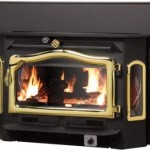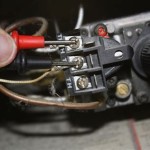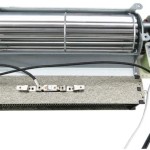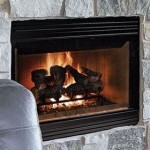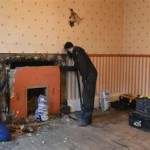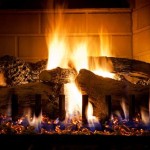Cement Fireplace Surround: Durability, Design, and Installation
A fireplace serves as a focal point in many homes, providing warmth and aesthetic appeal. The surround, the decorative facing around the fireplace opening, plays a crucial role in enhancing the fireplace's overall design and integrating it with the room's décor. Among the various materials available for fireplace surrounds, cement offers a unique combination of durability, design flexibility, and contemporary style. This article explores the characteristics, advantages, installation considerations, and maintenance aspects of cement fireplace surrounds.
Cement, in the context of fireplace surrounds, refers to a composite material primarily consisting of cement, aggregates (such as sand or gravel), and admixtures. The specific composition and manufacturing process can vary, resulting in different textures, colors, and performance characteristics. Cement surrounds are often cast or molded into various shapes and sizes, allowing for a wide range of design possibilities. They can mimic the look of natural stone, concrete, or even wood, offering versatility in complementing different architectural styles.
Unlike traditional brick or stone surrounds, cement offers the advantage of being able to be pre-cast in large sections, reducing the number of seams and simplifying installation. It can also be colored using integral pigments or surface treatments, providing a wide spectrum of aesthetic options. This adaptability makes cement an attractive choice for homeowners seeking a modern or minimalist look, as well as those wanting to replicate the appearance of more expensive natural materials at a lower cost.
Durability and Heat Resistance
One of the primary benefits of a cement fireplace surround is its inherent durability. Cement is a robust material that can withstand the heat generated by a fireplace, as well as everyday wear and tear. When properly installed and maintained, a cement surround can last for many years without significant degradation or damage. The material's resistance to cracking, warping, and fading makes it a long-term investment for homeowners.
The heat resistance of cement is a crucial consideration when selecting a fireplace surround. Cement-based products designed for fireplace applications are typically formulated to withstand high temperatures without compromising their structural integrity. The specific heat resistance can vary depending on the cement mix and the manufacturing process. It is important to consult with the manufacturer or installer to ensure that the chosen cement surround is suitable for the type of fireplace and the expected heat output.
Furthermore, cement is relatively non-combustible, which enhances the safety of the fireplace area. While it is essential to maintain proper clearances between the fireplace opening and any combustible materials, the use of a cement surround provides an additional layer of protection against fire hazards. Its low thermal conductivity also contributes to a more even distribution of heat, preventing localized hot spots and reducing the risk of burns.
Design Flexibility and Aesthetic Versatility
Cement fireplace surrounds offer a high degree of design flexibility, allowing homeowners to create a custom look that complements their individual style and the overall aesthetic of their home. The material can be molded into various shapes, sizes, and textures, ranging from sleek and minimalist to elaborate and ornate. This versatility makes cement suitable for a wide range of architectural styles, including contemporary, traditional, and rustic.
Cement can be integrally colored during the manufacturing process, providing a consistent and durable coloration throughout the material. This eliminates the need for painting or staining, which can require periodic maintenance. Integral coloring also allows for a wide range of color options, from neutral grays and whites to bolder hues. Alternatively, cement surrounds can be surface-treated with stains, sealers, or other decorative finishes to achieve a specific look.
The texture of a cement fireplace surround can also be customized to create different visual effects. Smooth, polished surfaces provide a modern and sophisticated look, while textured surfaces can mimic the appearance of natural stone or concrete. The use of molds and casting techniques allows for the creation of intricate patterns and designs, adding visual interest and depth to the fireplace area. This adaptability makes cement an ideal material for homeowners seeking a unique and personalized fireplace surround.
Moreover, cement can be combined with other materials, such as wood, metal, or glass, to create a mixed-media fireplace surround. This allows for further customization and the integration of different textures and design elements. For example, a cement surround can be paired with a reclaimed wood mantel to create a rustic and inviting look. The possibilities are virtually endless, limited only by the homeowner's imagination and the expertise of the installer.
Installation Considerations and Best Practices
The installation of a cement fireplace surround requires careful planning and execution to ensure proper fit, stability, and functionality. It is generally recommended to hire a qualified professional with experience in working with cement products. The installation process typically involves the following steps:
Preparation: The first step is to prepare the existing fireplace area by removing any existing surround, cleaning the surface, and ensuring that it is level and structurally sound. This may involve repairing any cracks or damage to the firebox or the surrounding wall. It is also important to verify that the fireplace meets all relevant building codes and safety regulations.
Measurements and Cutting: Accurate measurements are essential to ensure that the cement surround fits properly around the fireplace opening. The surround may need to be cut to size using specialized tools, such as a wet saw or a diamond blade. It is important to follow the manufacturer's instructions and to wear appropriate safety gear during the cutting process.
Adhesive and Mortar Application: The cement surround is typically attached to the fireplace using a combination of adhesive and mortar. The specific type of adhesive and mortar will depend on the type of cement surround and the substrate to which it is being attached. It is important to choose products that are specifically designed for high-temperature applications and that are compatible with cement.
Placement and Leveling: The cement surround is carefully positioned around the fireplace opening and leveled using shims or other leveling devices. It is important to ensure that the surround is plumb and that there are no gaps or voids between the surround and the fireplace. The adhesive and mortar are allowed to cure completely before proceeding to the next step.
Sealing and Finishing: Once the adhesive and mortar have cured, the cement surround may be sealed with a protective coating to prevent staining and water damage. The joints between the surround and the fireplace can be filled with grout or caulk to create a seamless and watertight finish. Any exposed edges or corners can be finished with trim or molding to provide a polished and professional look.
Proper installation is crucial not only for the aesthetics of the fireplace surround but also for its long-term performance and safety. A poorly installed surround can be prone to cracking, shifting, or even falling off, which can create a safety hazard. Therefore, it is always recommended to hire a qualified professional to ensure that the installation is done correctly.
Following best practices, such as using appropriate materials and techniques, can significantly enhance the lifespan and appearance of a cement fireplace surround. Regular inspections and maintenance, such as cleaning and sealing, can further extend its durability and prevent costly repairs. Addressing any issues promptly, such as minor cracks or stains, can help to preserve the beauty and functionality of the fireplace surround for many years to come.

Naturecast Concrete Fireplace Surrounds Cement Elegance

Maxwell Design Concrete Hearth Surround Cement Elegance

Naturecast Concrete Fireplace Surrounds Cement Elegance

Cornice Linen Cast Concrete Fireplace Mantel Classic Surrounds Seating

37 Stylish And Catchy Concrete Fireplaces Digsdigs

Concrete Fireplace Inspiration And Our Plan For The New Build Plank Pillow

Concrete Fireplace Inspiration And Our Plan For The New Build Plank Pillow

Latest Cost Free Cement Fireplace Surround Tips Concrete Fireplaces Can Turn An Ordinary Room Into Something Home Design Remodel

Naturecast Concrete Fireplace Surrounds Cement Elegance

Naturecast Concrete Fireplace Surrounds Cement Elegance
Related Posts


